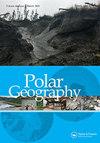Changes in sea ice travel conditions in Uummannaq Fjord, Greenland (1985–2019) assessed through remote sensing and transportation accessibility modeling
IF 1.6
Q3 GEOGRAPHY, PHYSICAL
引用次数: 5
Abstract
ABSTRACT Shorefast sea ice provides an important platform for winter and spring travel between coastal Arctic communities unconnected by road networks. In the past two decades, local Arctic residents have reported thinning and earlier breakup of shorefast ice. Despite these assertions, however, there are few quantitative assessments of how these changes have impacted travel on sea ice. In this study, we use high-resolution satellite remote sensing and transportation modeling to assess snow mobile travel in Uummannaq Fjord, Greenland. Following classification of satellite imagery, we generate optimal least-cost travel routes according to surface types present in the fjord. We then estimate distance and duration of snowmobile travel potential between communities from 1985 through 2019. We find that snowmobile travel in Uummannaq Fjord has potentially become slower and more unpredictable in recent years (2014–2019) relative to thirty years prior (1985–2000), with greater changes for communities located more proximal to the shorefast ice edge. Our results also suggest that reductions in on-ice snow cover impede snowmobile travel more than fractures do. Overall, our analysis demonstrates how remote sensing and transportation modeling may be used to quantify the community-scale impacts of changing shorefast ice conditions and has potential to help manage localized climate-related risk.基于遥感和交通可达性模型的格陵兰Uummannaq峡湾海冰旅行条件变化(1985-2019
滨岸海冰为北极沿海社区之间的冬季和春季旅行提供了一个重要的平台。在过去的二十年里,当地的北极居民报告说,滨冰变薄,并提前破裂。然而,尽管有这些断言,关于这些变化如何影响海冰旅行的定量评估却很少。在这项研究中,我们使用高分辨率卫星遥感和运输模型来评估格陵兰Uummannaq峡湾的雪地汽车旅行。根据卫星图像的分类,我们根据峡湾的地表类型生成成本最低的最佳旅行路线。然后,我们估计了从1985年到2019年社区之间雪地摩托旅行潜力的距离和持续时间。我们发现,与30年前(1985-2000年)相比,近年来(2014-2019年)Uummannaq峡湾的雪地摩托旅行可能变得更慢,更不可预测,更靠近滨快冰边缘的社区变化更大。我们的研究结果还表明,冰上积雪的减少比骨折更妨碍雪地摩托的行驶。总体而言,我们的分析表明,遥感和运输建模可以用来量化社区尺度上滨快冰条件变化的影响,并有可能帮助管理局部气候相关风险。
本文章由计算机程序翻译,如有差异,请以英文原文为准。
求助全文
约1分钟内获得全文
求助全文
来源期刊

Polar Geography
GEOGRAPHY, PHYSICAL-
CiteScore
5.30
自引率
0.00%
发文量
13
期刊介绍:
Polar Geographyis a quarterly publication that offers a venue for scholarly research on the physical and human aspects of the Polar Regions. The journal seeks to address the component interplay of the natural systems, the complex historical, political, economic, cultural, diplomatic, and security issues, and the interchange amongst them. As such, the journal welcomes comparative approaches, critical scholarship, and alternative and disparate perspectives from around the globe. The journal offers scientists a venue for publishing longer papers such as might result from distillation of a thesis, or review papers that place in global context results from coordinated national and international efforts currently underway in both Polar Regions.
 求助内容:
求助内容: 应助结果提醒方式:
应助结果提醒方式:


